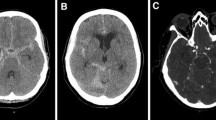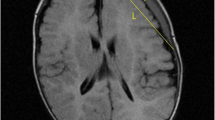Abstract
Aim
There is considerable disparity in literature as regards to the presentation of subdural fluid collections in children. In this report, the authors have tried to establish the clinical and radiographic criteria to define the subdural effusions (SDEs) in children following minor head injury.
Methods
Twenty cases of traumatic SDEs following minor head injury were studied prospectively. The age of these children ranged from 1 month to 2 years with an average of 9 months. The duration from the onset of first symptom to presentation in our outpatient department varied from 1 month to 13 months with a mean of 4.2 months. The duration of follow-up was 6 months to 2 years with an average of 10 months.
Results
Fourteen out of 20 (70%) children presented with subtle findings. Six out of 20 (30%) children presented with overt neurological signs and symptoms. Seizures were the most common mode of presentation in this group. Bilaterality and ventriculomegaly were more common in the subtle group, each with an incidence of 43%. Seven out of 20 (35%) cases required operative management of traumatic SDEs. Recurrence was seen in two of 20 (10%) cases who had been conservatively managed previously. Only one child showed conversion of traumatic subdural hygroma to chronic subdural hematoma on conservative management.
Conclusion
Traumatic SDEs in children following minor head injury need to be differentiated from other causes of subdural fluid collections in children. The clinical and radiological criteria proposed by us helps to identify this subset of cases in most of the children.





Similar content being viewed by others
References
Agarwal D, Mahapatra AK (2005) In: Mahapatra AK, Kamal R (eds) Minor head injury, 3rd edn. Modern, New Delhi, India, pp 123–128
Albuquerque FC, Giannotta SL (1997) Arachnoid cyst rupture producing subdural hygroma and intracranial hypertension: case report. Neurosurgery 41:951–956
Chugani HT, Muller RA, Dhugani DC (1996) Functional brain reorganization in children. Brain Dev 18:347–356
Hong DH, Lim HH, Bae WK, Kim PN, Kim IY, Lee BH et al (1994) Chronic subdural haematoma secondary to traumatic subdural hygroma. Korean J Radiol 30:219–224
Huh PW, Yoo DS, Cho KS, Park CK, Kang SG, Park YS et al (2006) Diagnostic method for differentiating external hydrocephalus from simple subdural hygroma. J Neurosurg 105:65–70
Kim BO, Kim SW, Lee SM (2005) Effectiveness of early surgery in children with traumatic subdural hygroma. J Korean Neurosurg Soc 37:432–435
Kumar R (2006) External hydrocephalus in small children. Childs Nerv Syst 22:1237–1241
Kumar R, Singhal N, Mahapatra AK (2007) Idiopathic chronic subdural haematoma, MCA infarct and cortical atrophy with status epilepticus in infants—report of two cases. Indian J Pediatr 74:1046–1048
Lee KS (1998) The pathogenesis and clinical significance of traumatic subdural hygroma. Brain Inj 12:595–603
Mayo CH (1894) A brain cyst: the result of injury causing aphasia, hemiplegia, etc.; evacuation; complete recovery. NY Med J 59:434
McConnell AA (1941) Traumatic subdural effusion. J Neurol Neurosurg Psychiat 4:237–256
Mild head injury interdisciplinary special interest group of the American Congress of Rehabilitation Medicine (1993) Definition of mild traumatic brain injury. J Head Trauma Rehabil 8:86–88
Murata K (1993) chronic subdural hematoma may be preceded by persistent traumatic subdural effusion. Neurol Med Chir (Tokyo) 33:691–696
Ohno K, Suzuki R, Masaoka H (1987) chronic subdural haematoma preceded by persistent traumatic subdural fluid collection. J Neurol Neurosurg Psychiatry 50:1694–1697
Rupprecht T, Lauffer K, Storr U, Hofbeck M, Wenzel D, Böwing B (1996) Extra-cerebral intracranial fluid collections in childhood: differentiation between benign subarachnoid space enlargement and subdural effusion using color-coded duplex ultrasound. Klin Padiatr 208:97–100
Schaeybroeck PV, Vanlommel E, Lagae L, Calenbergh FV, Casaer P, Plets C (1999) Treatment of a symptomatic posterior fossa subdural effusion in a child. Childs Nerv Syst 15:2
Sohn IT, Lee KS, Doh JW, Bae HG, Yun IG, Byun BJ (1997) A Prospective study on the incidence, patterns and premorbid conditions of traumatic subdural hygroma. J Korean Neurosurg Soc 26:87–93
Stone JL, Lang RG, Sugar O, Moody RA (1981) Traumatic subdural hygroma. Neurosurgery 8:542–550
Yamada H, Kageyama N, Nakajima M, Nakamura S (1979) Acute post-traumatic subdural hematoma in infancy: special reference to the mechanism of collection of subdural fluid. No Shinkei Geka 7:55–62
Yamada H, Nihei H, Watanabe T, Shibui S, Murata S (1979) Chronic subdural hematoma occurring consequently to the posttraumatic subdural hygroma—on the pathogenesis of the chronic subdural hematoma. No To Shinkei 31:115–121
Acknowledgements
The author is grateful to Mr. A. P. Dhar Dwivedi, Department of Neurosurgery, SGPGIMS, Lucknow, for secretarial assistance.
Author information
Authors and Affiliations
Corresponding author
Rights and permissions
About this article
Cite this article
Kumar, R., Singhal, N. & Mahapatra, A.K. Traumatic subdural effusions in children following minor head injury. Childs Nerv Syst 24, 1391–1396 (2008). https://doi.org/10.1007/s00381-008-0645-1
Received:
Revised:
Published:
Issue Date:
DOI: https://doi.org/10.1007/s00381-008-0645-1




